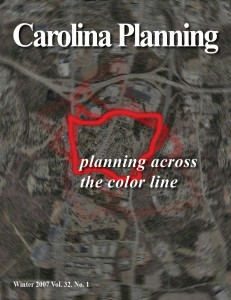 Volume 32.1 Planning Across the Color Line (2007)
Volume 32.1 Planning Across the Color Line (2007)
Despite significant progress, the American legacy of racial division and discrimination continues to bedevil our society as it enters the 21st Century. Planners struggle daily with the many issues situated squarely at the intersection of planning and race—including everything from racially motivated zoning decisions, to disaster response planning, inequitable development patterns, and the role of minorities in the planning profession itself. In this issue of Carolina Planning, we take a deeper look at this intersection of planning and race.
Editors: Dorothy Ariail, Allan Freyer, and Alexandra Moravec
A digital version of this issue is available here.
| SAVING NORTHSIDE: THE VALUE OF NEIGHBORHOOD CONSERVATION DISTRICTS
Bailey, Delores; Waldon, Roger In the past few decades, economic growth in Chapel Hill has fueled the demand for housing in the town and put increasing development pressure on many of the town’s traditional neighborhoods. Northside, a historically African-American neighborhood near downtown Chapel Hill, began experiencing these development pressures in the 1990s as new construction in the neighborhood began increasing rapidly. In response to these pressures, Northside residents worked together with town officials to establish a Neighborhood Conservation overlay district to constrain development in ways that would preserve the character of this long-standing neighborhood. This article describes the specific development pressures facing Northside, the collaborative strategy used to develop this Neighborhood Conservation District, and the benefits reaped by the community following its implementation. |
| STANDARDS FOR EXTENDING EXTRA-TERRITORIAL JURISDICTION: WRITTEN IN BLACK AND WHITE?
Joyner, Ann Moss The following article examines the public outcry surrounding one town’s attempt to establish an extra-territorial jurisdiction (ETJ). Most towns easily establish ETJs with little or no resistance. In contrast, when the predominantly minority Town of Green Level attempted to use this common planning tool, it faced inordinately strong and negative public resistance. The author addresses each of the arguments made by members of the public against Green Level’s proposed ETJ, and finds that each argument is unfounded. In the end, she finds, the only difference between the Town of Green Level and its neighbors, who were allowed to extend ETJs, is that of racial composition. |
| EQUITY: THE SILENT “E” IN SUSTAINABILITY
Reece, Jason; Gambhir, Samir; Rogers, Christy Though social equity is a critical part of sustainable development, local municipalities often focus more on environmental protection and economic prosperity than on equity when making land use decisions. The authors of this article examine land use decisions in Richland County, South Carolina that appeared to address growth pressures without taking equity issues into account. The authors also present a conceptual framework for addressing the tension between the three fundamental principles, and then conclude by discussing ways to apply this framework to help bridge the gap between smart growth and social equity. |
| PLANNING TO OVERCOME RACISM: A LOOK INTO KANSAS CITY’S HUMAN INVESTMENT PLAN
Gourgechon, Jacques A. Racism is still a pervasive problem in today’s cities, and successful urban planning requires addressing this problem in both its blatant and subtle manifestations. An adaptation of an article submitted to the 1998 National Planning Conference, this paper describes the course of action taken by Camiros, Inc. in combating racism through the FOCUS Kansas City Human Investment Plan; the suggestions and findings discussed in the plan can be used by other cities looking for a game plan for addressing racism in a comprehensive manner. |
| EMERGENCY PREPAREDNESS IN DISADVANTAGED COMMUNITIES: AN INTERVIEW WITH DR. JOHN COOPER
Carolina Planning Editors Dr. John Cooper currently serves as the director of the Emergency Preparedness Demonstration Project for MDC, Inc. An alumnus of the University of North Carolina at Chapel Hill, Cooper has consulted for the North Carolina Department of Emergency Management’s Hazard Mitigation Program, and currently serves as a board member for the North Carolina Smart Growth Alliance . Carolina Planning (CP) interviewed Dr. Cooper on October 20, 2006 about the Emergency Preparedness Demonstration Project and its efforts to help low-income, minority communities build capacity for emergency response and preparedness. |
| TELLING THE PLANNING DIVERSITY STORY
Silver, Mitchell Over the past 25 years, the planning profession has become aware of a troubling lack of diversity in its membership, leadership, and professional development process. Efforts to increase racial, cultural, and economic diversity within the planning profession span a 25-year period, with a deeper commitment by the American Planning Association (APA) especially evident since the late 1990s. Written by one of the leaders in the diversity-in-planning movement, this article discusses these efforts and provides a series of recommendations made by the APA Diversity Taskforce in 2005 to increase diversity in the planning profession. |